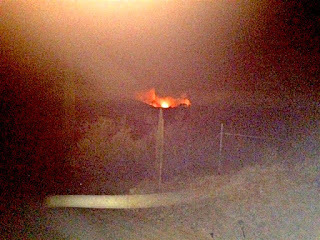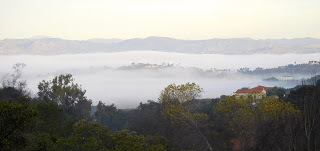Living on the Edge, Part I
 Welcome to our neighborhood
Welcome to our neighborhoodLorna and I were once led on a safari in Botswana by a guide with the un-bwanna-like name of Bruce whose stated philosophy of life was, “If you’re not living on the edge, you’re taking up too much room”. At first we found it mildly amusing, but it lost its charm when he led us into the bush for the second time and so provoked a white rhino that it charged the jeep where he’d tucked our party away while he moved in for a close-up photo. The rhino, fortunately, had more common sense than Bruce and veered off in another direction in time for us to get out of there. I would never-ever describe myself as someone who lives dangerously, but the sign above marks the entrance to our neighborhood where we’ve lived happily for more than 25 years. It is not a seasonal sign; it’s up all the time (having replaced a billboard-sized sign that was there when we first moved in and…almost as a taunt to nature…was made of wood). And, please note, our neighborhood has not become a fire risk zone as a result of climate change. When we first moved in and attended a neighborhood fire safety meeting, the fire marshal told us that wildfires were cyclical in our area and we were due for one…so it wasn’t a matter of if, but when. Still, with open eyes we bought our home here (on Flametree Road no less!) and have made considerable improvements in it over the years under the real threat of it all going up in flames one day pushed to the backs of our minds. Not too far back, mind you: Some of the changes we’ve made have been for the express purpose of mitigating the damage of a wildfire. In this I suspect we’ve been no more or less conscientious than many of our fellow Californians who, alas, still lost their homes to the state’s increasing epidemic of fierce, uncontrolled burns.
 Where we live:
Where we live:During a recent fire scare flames loomed just beyond our
driveway looking like lava spitting up from VesuviusThis enormous gamble that we’ve taken not only with our most valuable material possessions but our lives as well has stoked my nearly lifelong fascination with the doomed city of Pompeii. I don’t give a second’s thought to the notion of reincarnation, but if I did I could be easily convinced that I am the reanimated soul of a body burned and buried there in 79 AD. There’s something about Pompeii that calls to me…and recently inspired me to plug in the earbuds and listen to classicist Mary Beard’s 2008 study, Pompeii, The Fires Of Vesuvius Pompeii Lost and Found. The book begins with the description of a couple who had attempted to escape the city by its eastern gate. Among the couple’s remains found in 1907 was a key, Beard says, that was beautifully molded in the shape of an African’s head. Though its utility is unclear (key to house, hope chest, jewelry box?), Beard tells us it must have been an expensive key--speaking of the couple’s successful past--and its presence in their possession at their dying moments spoke of their hopeful future. The scene resonated with me immediately. On our visit to Pompeii, we made the essential side visit to the National Archaeological Museum in Naples where many of the artifacts from Pompeii are kept. There we encountered a boxed set of dinnerware stored away by its owners and preserved by Vesuvius’s hardened lava. The label that accompanied the exhibit noted how the care with which the owners stored their belongings reflected their optimism in returning.
These anecdotes about the fated key and fated dinnerware speak broadly about people who live on the edge. That is, though it takes a certain amount of fatalism to live in a danger zone…be it danger from fire, flood, volcano, what have you…most people do so with a sense of faith that after a cataclysm life will resume. This determination to stare down a potential apocalypse is not wholly admired throughout society, however. Coverage of wildfires in California is inevitably accompanied by stories of those who ignore evacuation orders and refuse to abandon their homes. We see this repeated under threats of hurricane warnings in the Southeast and tornado warnings in the Southwest, so it’s not just a California thing. But wherever it happens it does tend to raise the ire of others who either don’t like the idea of common sense being dismissed or bailing out those who willfully tempt fate.
Which always seems to raise the unpleasant question: what’s the obligation of the rest of society to people who choose to live close to the edge when disaster strikes? Personally I shake my head in disdain every time a story breaks about some daredevils who decided to challenge nature on a lark against all good advice and ended up draining precious public funds to rescue them. But is what they did any different than the risk we took in moving into this neighborhood? Is it any different from the residents of Pompeii who remained after experiencing a devastating eruption of Vesuvius 17 years before the ultimate one that buried the city for centuries?
Speaking from my obviously biased position, I think there’s a significant difference. First of all, few people move into danger zones on a lark…for the thrill of it. We’re not living here on the edge of apocalypse for the adrenalin rush…quite the opposite in fact. We’re here for the beauty and tranquility of the place…and the danger, like the mortgage (and the taxes!), is part of the price we have to pay. The same goes for those who live in such places because of their jobs or families. Sometimes danger zones become dangerous after they’ve been settled and people have built a lifestyle and enacted public policies around management of the danger. Most importantly, people who live on the edge, as opposed to those who merely play on the edge, are invested in it. They’re not just waiting to be helicoptered out of harm’s way, but are willing and eager to return after disaster…precious keys in hand…to rebuild.
 Why we live here:
Why we live here:Looking off in the same direction from the driveway,
most days it looks idyllicPeople are not generally existential nihilists about the places they live. We carve out living spaces in inhospitable environments because that’s what we’ve always done as a species…it’s in our nature and it’s what accounts for our ability to flourish all over the globe. In rare instances do we consciously set about turning our habitat into a death trap because we don’t care what happens to it or us. That’s nihilistic behavior. There have always been nihilists among us, but civilized societies have been able to put laws and norms in place to stop them from exerting their self-destructive impulses on the rest of us. What happens, though, when by hook and crook they wrest control from the rest of us? What happens when by dint of fanaticism and intransigence those who believe that human evolution is damnable start pushing us closer and closer to a metaphysical edge?
Next post: Living on the Edge, Part II
Published on November 23, 2019 19:33
No comments have been added yet.



